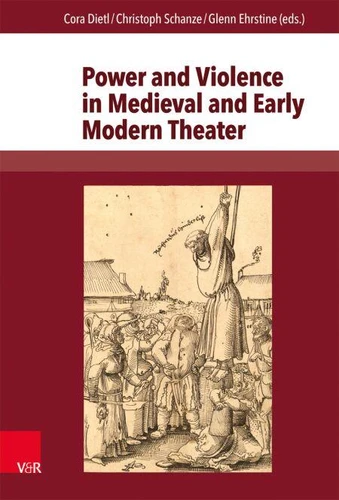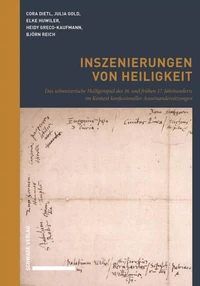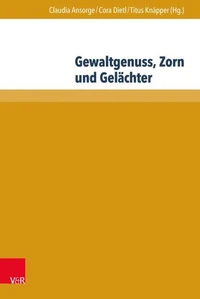Power and Violence in Medieval and Early Modern Theater
Par : , , , ,Formats :
Disponible dans votre compte client Decitre ou Furet du Nord dès validation de votre commande. Le format PDF est :
- Compatible avec une lecture sur My Vivlio (smartphone, tablette, ordinateur)
- Compatible avec une lecture sur liseuses Vivlio
- Pour les liseuses autres que Vivlio, vous devez utiliser le logiciel Adobe Digital Edition. Non compatible avec la lecture sur les liseuses Kindle, Remarkable et Sony
 , qui est-ce ?
, qui est-ce ?Notre partenaire de plateforme de lecture numérique où vous retrouverez l'ensemble de vos ebooks gratuitement
Pour en savoir plus sur nos ebooks, consultez notre aide en ligne ici
- Nombre de pages237
- FormatPDF
- ISBN978-3-8470-0316-8
- EAN9783847003168
- Date de parution17/09/2014
- Protection num.pas de protection
- Taille3 Mo
- Infos supplémentairespdf
- ÉditeurV&R Unipress
Résumé
Theater historians were discussing the particular type of violence displayed by medieval religious plays long before cultural studies discovered violence as a favored topic. The present volume, which gathers selected papers of the first regional colloquium of the Société Internationale pour l'Étude du Théâtre Médiéval (SITM) in Germany, draws upon recent sociohistorical work on the phenomenon to reconsider past paradigms for the function of violence on the medieval stage, including the concept of compassio.
The authors argue that an important key to the understanding of violence in medieval and early modern theater can be found in the relationship between violentia, vis, and potestas (violence, force, and power). The plays normally do not present violence as an isolated feature, but rather as an expression or a means of power. They thereby address the legitimacy of power, both on the page and in performance.
The time frame for the plays under discussion (c. 1470-1570) elides the traditional border line between late medieval Catholicism and the Protestant Reformation. The essays clearly reveal that the depiction of violence, while altered in character and function by post-Reformation confessional debates, nonetheless remained a central feature of the new Protestant theater as well.
The authors argue that an important key to the understanding of violence in medieval and early modern theater can be found in the relationship between violentia, vis, and potestas (violence, force, and power). The plays normally do not present violence as an isolated feature, but rather as an expression or a means of power. They thereby address the legitimacy of power, both on the page and in performance.
The time frame for the plays under discussion (c. 1470-1570) elides the traditional border line between late medieval Catholicism and the Protestant Reformation. The essays clearly reveal that the depiction of violence, while altered in character and function by post-Reformation confessional debates, nonetheless remained a central feature of the new Protestant theater as well.
Theater historians were discussing the particular type of violence displayed by medieval religious plays long before cultural studies discovered violence as a favored topic. The present volume, which gathers selected papers of the first regional colloquium of the Société Internationale pour l'Étude du Théâtre Médiéval (SITM) in Germany, draws upon recent sociohistorical work on the phenomenon to reconsider past paradigms for the function of violence on the medieval stage, including the concept of compassio.
The authors argue that an important key to the understanding of violence in medieval and early modern theater can be found in the relationship between violentia, vis, and potestas (violence, force, and power). The plays normally do not present violence as an isolated feature, but rather as an expression or a means of power. They thereby address the legitimacy of power, both on the page and in performance.
The time frame for the plays under discussion (c. 1470-1570) elides the traditional border line between late medieval Catholicism and the Protestant Reformation. The essays clearly reveal that the depiction of violence, while altered in character and function by post-Reformation confessional debates, nonetheless remained a central feature of the new Protestant theater as well.
The authors argue that an important key to the understanding of violence in medieval and early modern theater can be found in the relationship between violentia, vis, and potestas (violence, force, and power). The plays normally do not present violence as an isolated feature, but rather as an expression or a means of power. They thereby address the legitimacy of power, both on the page and in performance.
The time frame for the plays under discussion (c. 1470-1570) elides the traditional border line between late medieval Catholicism and the Protestant Reformation. The essays clearly reveal that the depiction of violence, while altered in character and function by post-Reformation confessional debates, nonetheless remained a central feature of the new Protestant theater as well.





